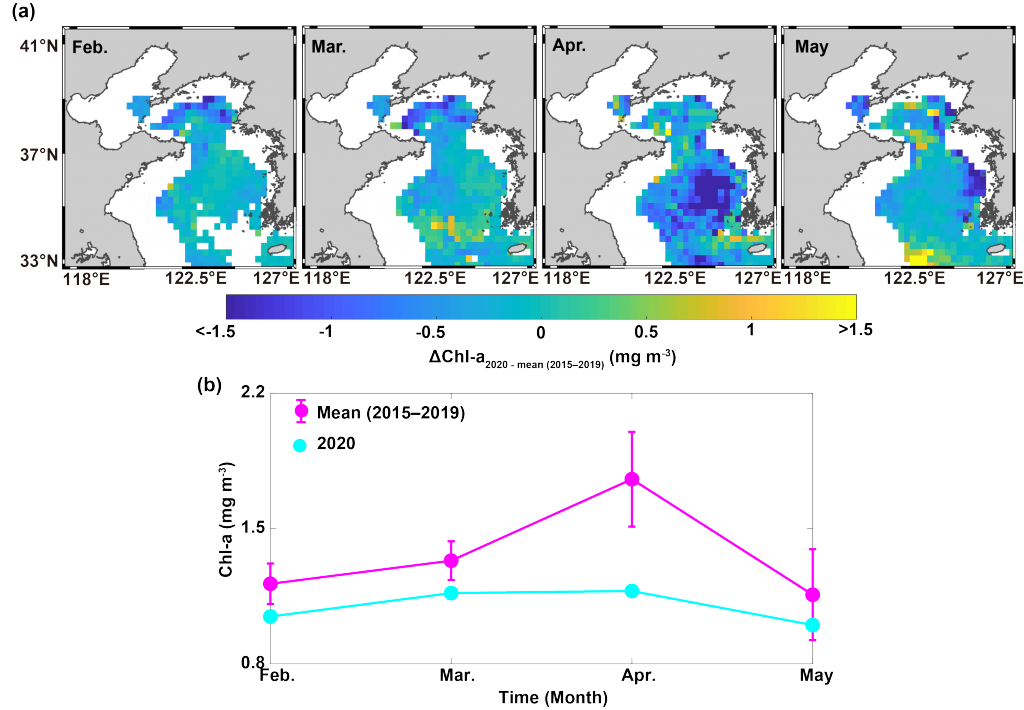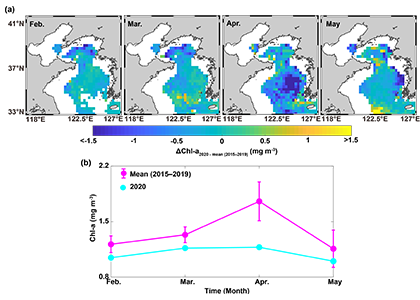Recently, it was reported that the coronavirus (COVID-19) pandemic-related lockdowns have led to a reduction in anthropogenic emissions of pollutant nitrogen on a global scale. This reduction may have induced a change in marine environmental conditions, providing a natural experiment for determining its impact on marine ecosystems. However, a direct cause-effect relationship between COVID-19 and the phytoplankton biomass has not yet been fully explored.
A recent study published in Marine Pollution Bulletin, investigated a change in satellite-derived chlorophyll-a concentrations (Chl-a) as a result of the COVID-19 lockdown. The high productivity of the Yellow Sea ecosystem is considered to be significantly attributable to high nutrient supply via atmospheric deposition from nearby anthropogenic sources of air pollution, making it an ideal location to observe this natural experiment. Further, they evaluated a significant contributing factor to change in irradiance, vertical mixing, coastal influence, and air pollutant deposition through a comparative analysis of in situ, reanalysis, and satellite-derived datasets during February‒May 2020 (representing the period of COVID-19 lockdown effect) as compared to the same period in the previous five-years (2015–2019; representing the period of no COVID-19 lockdown).

Figure 1. (a) The spatial distribution of the difference in the monthly mean Chl-a concentrations over the Yellow Sea between 2020 and 2015–2019 (ΔChl-a2020 ‒ mean (2015–2019)) in February, March, April, and May. (b) The monthly mean Chl-a averaged for the Yellow Sea (32.625–41.625 °N, 117.375–127.375 °E) during February to May 2015–2019 (pink marker) and 2020 (cyan marker). The vertical solid lines represent their standard deviation for the 2015–2019.
The authors captured a significant decline in Chl-a (~30%) over the Yellow Sea during February‒May 2020 compared to February‒May 2015‒2019 (Figure 1). Variations of irradiance, vertical mixing, and river discharges, were not major factors affecting this decline. Based on the analysis of transportation and constituent of atmospheric pollutants from Northern China (i.e., representing main source region of atmospheric pollutants) to Yellow Sea, the decline in Chl-a over the Yellow Sea during spring 2020 was mainly attributed to decreased atmospheric nutrient deposition due to the COVID-19 lockdown effect, a consequence of decreased anthropogenic emissions in the Northern China. Thus, further investigation is required to assess the Yellow Sea ecosystem response to re-increasing anthropogenic activities once the COVID-19 lockdown restrictions are lifted.
Authors:
Joo-Eun Yoon (Centre for Climate Repair at Cambridge, Cambridge University)
Seunghyun Son (CIRA, Colorado State University)
Il-Nam Kim (Department of Marine Science, Incheon National University)




